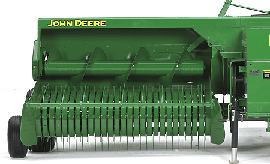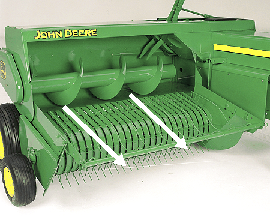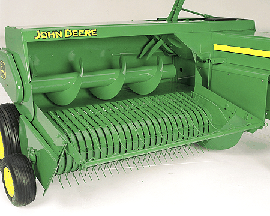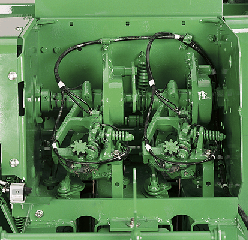Specifications
 Square baler pickup
Square baler pickup
The pickup teeth and narrow, flanged strippers extend to the flare on both sides of the pickup. This enables full, usable pickup width for feeding wide windrows.
Closely-spaced pickup teeth gather all of the hay in wide, heavy windrows.
Baler |
Number of teeth |
328 |
104 |
338 |
156 |
348 |
156 |
Narrow-channel strippers positioned closely together help preserve leaves and short material to add more quality to the bale.
The pickup is 188-cm (74-in.) wide on flare and offset 25.4 cm (10 in.) to the right of the bale case.
- The full width of the pickup can be utilized without the tractor tires operating on the windrow.
The belt drives used to power the pickup are virtually trouble-free and eliminate the need for slip clutches.
 Small square baler pickup with hay compressor
Small square baler pickup with hay compressor
The adjustable hay compressor mounts to and floats with the pickup and helps to maintain the same relationship to the pickup teeth at all operating heights.
The hay compressor also controls hay for continuous positive delivery to the auger.
The hay compressor is adjustable to nine positions to maintain positive control of hay in either large and heavy or light and fluffy windrows.
It can easily be removed with two spring pins for access to the auger or feed opening.
 Pickup and deep-flighted auger
Pickup and deep-flighted auger
The deep-flighted auger continuously moves hay away from the pickup to the pre-compression chamber:
- Adds to the overall capacity
- Produces higher-quality hay
- Allows minimal crop contact with pickup teeth, which minimizes leaf loss
The free-floating auger raises or lowers to match and maintain control of incoming crop.
Hay turns in the tapered auger housing, which enables the feeder forks to fold each charge as it enters the bale case to produce uniform bales. The crop is pre-compressed for better bale uniformity.
The auger system has few moving parts for less wear and less chance of untimely breakdowns.
 Small square baler knotter system
Small square baler knotter system
Knotters driven by shaft and gears provide a positive drive for dependable and accurate functioning.
The timing of knotters and needles is easy:
- Remove one bolt and match the gears
- Timing slot enables easy positioning of the plunger
The tucker finger holds the twine over the billhooks during the tying cycle:
- Eliminates twine finger
- Reduces the chance of twine damage
- Notch controls the twine position over the billhook for improved knotter function
- Ball-joint-style pull links ensure accurate adjustment
The twine knife is made of surgical-quality steel and can be easily unbolted for sharpening or replacement.
The adjustable edge on the wiper arm allows an easy, accurate adjustment to the billhook.
The positive meshing of knotter gears is easily maintained with spring pins and washers on the needle lift shaft.
The large-diameter needle-lift shaft increases strength for reliable operation.
The split-design knotter frame enables easy removal, without disassembly of the entire mechanism.
A coil-type tension spring on the twine holder enables easy adjustment and improved performance.
The twine disk timing is easily accomplished without removing the pinion gear.
Making adjustments is easy when changing from multi-twine billhooks to sisal-twine billhooks.
The billhook cam track is a separate hardened part that can be replaced independently from the knotter frame, which reduces repair costs.

